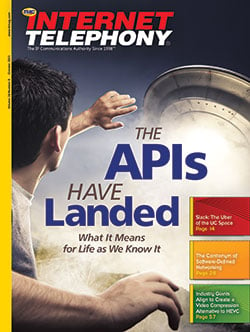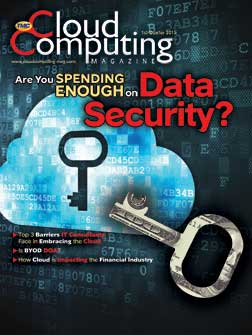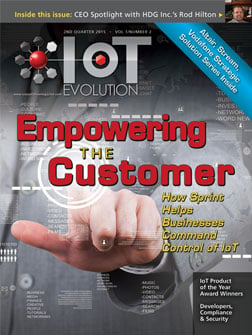(This article first appeared in the July 2008 issue of INTERNET TELEPHONY.)
The dream of Unified Communications (UC) and Fixed-Mobile Convergence (News - Alert) (FMC) is to be able to seamlessly roam with a mobile communications device from an interior office to the outside cellular world. Until now it was thought that IMS (IP Multimedia Subsystem), the world’s upcoming common service architecture for wireless and wireline networks, would provide the underlying foundation for this. However, IMS is subject to some competition by UMA (Unlicensed Mobile Access), a technology pioneered by Kineto Wireless that provides roaming between GSM/GPRS and 802.11 (WiFi), based on the 3GPP Generic Access Network (GAN) standard.
With UMA, GSM/GPRS core network services can be accessed via IP-based broadband connections, thanks to a new network element, the UMA Network Controller, or UNC, and various associated protocols that enable secure transport of GSM/GPRS signaling and user plane traffic over IP. The UNC interfaces into the core network via existing 3GPP-specified A/Gb interfaces. In September 2004, UMA-friendly companies introduced the UMA specifications to the 3GPP for consideration as a formal standard. In April 2005, the UMA specifications were formally incorporated into Release 6, thus making UMA a 3GPP standard for FMC. Within the 3GPP specifications, UMA is referred to as Generic Access to A/Gb interfaces, and contained within TS 43.318.
As for security, the 3GPP UMA standard allows the use of an IPsec tunnel originating in the handset and terminating on the UNC in an operator’s core network. The UNC terminates the IPsec tunnel and handles user login and authentication to the mobile core network.
At one time considered a “quick fix” for those carriers either too timid to adopt a full IMS system or else unable to adopt one because of a lack of second source equipment, UMA can work within the IMS environment if need be, and in any case, it has continued to make its way through many of the world’s telcos (AT&T/Cingular, BT, Cincinnati Bell, Fido, Ono, France Telecom/Orange, O2, Rogers Wireless, Saunalahti, T-Mobile USA, TeliaSonera, etc.) and the technology is supported by many vendors.
Dual-mode cellular/WiFi handsets are perhaps the most familiar incarnation of UMA technology and service. They’re the epitome of devices enabling mobile subscribers to automatically and seamlessly roam and handover between cellular networks and public and private WiFi networks, thus delivering a consistent user experience for voice, data and other services as one transitions between networks.
The list of UMA-enabled dual-mode handsets is a long one, and includes the BenQ e72, Blackberry RIM 8120, Blackberry RIM 8320, HP iPAQ 510, HTC Shadow II, LG KE520, Motorola A910, Motorola Z6w, Nokia 6086, Nokia 6301, Sagem my419, Sagem my429x, Samsung P180, Samsung P220, Samsung P260, Samsung t339, Samsung t409 and the Samsung T739.
This list’s most recent addition (at the time of writing) is the Research In Motion (RIM) BlackBerry (News - Alert) Pearl 8120 smartphone for Canadian customers of Rogers Wireless. It supports Rogers Home Calling Zone, a UMA-based service from Rogers enabling unlimited voice calls over a WiFi Internet connection in the home and cellular service when a subscriber walks outside. Aside from WiFi (802.11 b/g), the phone comes with a 2 megapixel camera with 5x digital zoom, built-in flash and video recording capability, a media player; support for high speed USB 2.0 for transferring of files between a PC and the smartphone; accessible microSD/SDHC expandable memory slot for additional storage; and support for downloading music directly from the Rogers MusicStore.
The BlackBerry Pearl 8120 also runs Rogers’ Do More portal for access to many mobile-enabled business and personal applications; instant messaging option with BlackBerry Messenger, Google Talk and Yahoo! Messenger also support for the increasingly popular Facebook for BlackBerry Smartphones app.
As for Kineto Wireless, its Fixed-Mobile Convergence (FMC) solutions include femtocells, dual-mode handsets, terminal adaptors and soft mobiles at home, offices and public wireless LANs. They are a leading supplier of UMA-compliant core network solutions to operators worldwide, and they supply UMA-compliant client software solutions to mobile device manufacturers. Seeing that femtocells (which provide radio coverage for standard 3G handsets within a home or office) are on the verge of becoming a major market, Kineto began to help develop a consensus among the contributing femtocell companies. Kineto announced support for the recent 3GPP agreement Home NodeB (HNB) architecture for femtocell-to-core network connectivity.
The 3GPP itself defines 3G femtocells as a new kind of network element called a “Home NodeB” or HNB. A Node B is the local element of a 3G macro RAN (Radio Access Network), and a femtocell performs Node B functions along with the radio resource management functions of an RNC (Radio Network Controller), though it is optimized for home use. The 3GPP’s WG3 (RAN Working Group 3) is developing a standard interface between a 3G femtocell and the mobile core network. The WG3 has finally formulated a reference architecture leading to a new HNB standard that should be completed around December 2008.
Aside from the HNB (femotocell) the second new network element defined by the 3GPP is the “Home Node B Gateway” (HNB-GW, often called the “femto gateway”) that sits in an operator’s network and aggregates traffic from many HNBs and sends it into an the core service network through the standard Iu-cs and Iu-ps interfaces. Linking the HNB and the HNB-GW is a new interface known as “Iu-h” which defines both a security architecture as well as an efficient and reliable method for transporting Iu-based traffic. Recently, it was decided that this Iu-h interface will be based on Iu, not UMA/GAN, SIP (Session Initiation Protocol), or Iu-b. This new Iu-h interface will also be associated with a new protocol (HNBAP) for enabling highly scalable ad-hoc HNB deployment, as well as a new methodology for transporting Iu control signaling over the Internet.
One would think that femtocells would be more of a competitor to UMA, but Kineto’s Director of Marketing, Steve Shaw, explained to me that “UMA can also be used for femtocells, providing an inexpensive backhaul conduit to the controller.” Kineto has been working with femtocells from their earliest days, having worked with Ubiquisys back in 2006 in the U.K. with tests of their ZoneGate 3G femtocell system working in conjunction with Kineto’s UMA controller. (Ubiquisys has received an impressive $40 million from Google, Atlas Venture, T-Mobile Venture Fund, and other investors in support of its plans to be selling femtocells to the public by the end of 2008.) A few months later, in 2007, NEC started bundling Kineto’s UMA controller with its own femtocells.
Within recent months, there has been a quickening pace to UMA announcements, particularly important ones relating to UMA testing and underlying support technologies. For example, the testing and monitoring solutions giant, Tektronix Communications, recently enhanced its advanced monitoring system, the Unified Assurance solution for mobile networks, to include UMA support. Now, networks incorporating UMA can enjoy end-to-end monitoring of voice and data sessions across fixed and mobile networks via this single Tektronix (News - Alert) platform. Tektronix' Unified Assurance UMA solution gives service providers an extensive view of voice and data service performance from access to core, including handovers between UMA and GSM/GPRS networks. This Tektronix UMA offering is fully integrated with the existing GeoProbe and Advanced Performance Monitoring (APM) applications and features. All are part of Tektronix' Unified Assurance suite of apps for management of next-gen converged networks.
In the same vein, Kineto Wireless is collaborating with Agilent Technologies 3G and 2G UMA/GAN handset testing. They’re working on expanding Agilent's (News - Alert) 8960 "real world" UMA/GAN test capabilities to provide a comprehensive, non-scripting test solution for mobile operators, handset vendors and platform developers in the UMA/GAN market. The collaboration’s first phase is intended to result in a robust 3G/2G UMA/GAN development and engineering validation tool that Kineto will showcase at its UMA Labs in Milpitas, California.
And in the back office, service providers deploying any kind of FMC service face more complicated challenges in terms of ensuring that subscribers from different networks are easily authenticated and authorized for access, and avoiding duplicate subscriber databases which increase costs and network complexity, and reducing revenue leakage and churn stemming from an inability to manage subscriber session records for billing.
Familiar devices such as a Home Location Register (HLR) were originally designed to handle authentication for voice services only, so, for today’s next-gen providers, Bridgewater Systems has announced that its AAA Service Controller now supports 3GPP compliant FMC deployments based on UMA as well as Voice Call Continuity (VCC) and Wireless LAN (WLAN) architectures. Bridgewater’s FMC solution allows GSM/UMTS and fixed-service providers worldwide to be able to dynamically support subscribers, regardless of whatever access network they choose, and provide a seamless subscriber service experience, operational efficiencies, and a migration path to support high bandwidth, wireless, Long-Term Evolution (LTE) technology and converged IMS core networks.
Other supporters of UMA include Alcatel, Ericsson, Motorola, Nokia, Nortel (News - Alert) Networks, Siemens and Sony Ericsson. Like it or not, UMA will continue to be a player, both in business and in the home, for many years to come.
Richard Grigonis is Executive Editor of TMC�s IP Communications Group. To read more of Richard�s articles, please visit his columnist page.Edited by Erik Linask
 Internet Telephony Magazine
Click here to read latest issue
Internet Telephony Magazine
Click here to read latest issue CUSTOMER
CUSTOMER  Cloud Computing Magazine
Click here to read latest issue
Cloud Computing Magazine
Click here to read latest issue IoT EVOLUTION MAGAZINE
IoT EVOLUTION MAGAZINE




